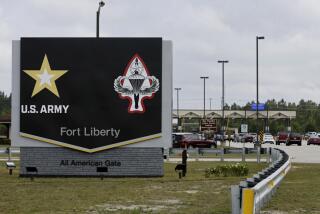CANADA : U.S. Base Leaves Lasting Legacy of Friendship--and Pollution
- Share via
ARGENTIA, Canada — Weeds sprout in the cracked airstrip that once rumbled with U.S. military aircraft. Neat suburban homes that housed U.S. naval officers and their families sit empty. The playground equipment outside the base school is deserted, and barbells gather dust in the gym.
The Yanks are gone from this corner of Newfoundland in a final retreat from half a century of U.S. military presence on the rugged island. They left a legacy of friendship, poignant memories and thousands of marriages with Newfoundlanders, which helped forge a special bond between the people of the province and many in the United States that endures today.
But the Americans who vacated the Argentia Naval Facility 10 months ago also left some unfinished business: Buried in places around the base, which rambles across a fork of land jutting into the Atlantic, are undetermined amounts of PCBs, jet fuel and other pollutants. Although of no known immediate danger to residents, the chemicals have contaminated fish in nearby waters with poisonous levels of PCBs, said Kevin Aylward, Newfoundland’s environment minister.
The Pentagon already has committed itself to cleanup work estimated to cost $5 million. But whether that will be enough is a matter of continuing negotiation. Canadian scientists are finishing an environmental assessment of the base for use in the talks. Representatives of both sides predict agreement by year’s end.
For Canadian officials hoping to turn the base into something more than an artifact of Newfoundland’s history, solving the pollution problem is a key to attracting major investors in redevelopment. Unemployment in surrounding communities shot up to 70% when the Navy moved out.
Argentia was the first of four large U.S. military bases built in Newfoundland to guard the North Atlantic sea lanes to Europe in World War II. The bases were leased to the United States by Britain in return for U.S. destroyers and other war material under the Lend-Lease Act of 1941, when Newfoundland was a British colony. (Newfoundlanders voted their way into Canada in 1949.)
The wartime arrival of more than 20,000 brash, free-spending U.S. sailors, soldiers and airmen in rural, close-knit Newfoundland, where most people rarely ventured out of their home village, precipitated a social earthquake that changed the island forever.
Families tied for centuries to their farms or fishing boats found new types of work. Teen-age girls who were raised on traditional music sung ‘round the fireplace swooned at Frank Sinatra’s USO concert.
Most significant were the intermarriages between Americans and Newfoundlanders, more than 25,000 all together, according to “A Friendly Invasion,” a history of the U.S. military here by John N. Cardoulis.
Argentia, the surviving U.S. outpost, curtailed operations drastically in the late 1960s, then closed in October.
The Canadian government is trying to lure manufacturers to the base, but the going is slow. A glove factory is moving into one building, a mushroom farm is setting up in another, and a cold-storage transport firm is using some old port facilities. But the abandoned buildings far outnumber those in use.
More to Read
Sign up for Essential California
The most important California stories and recommendations in your inbox every morning.
You may occasionally receive promotional content from the Los Angeles Times.













